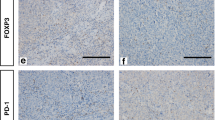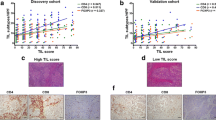Abstract
The prognostic variability recorded within homogeneous groups of patients for anatomo-clinical disease stages has led to a more detailed biological characterization of breast cancer. Recently, the attention of the scientific community has focused on the role of tumor-infiltrating lymphocytes (TILs). Therefore, the need of an in-depth immunomorphological characterization of TILs has been emerged. The presence of TILs has been retrospectively investigated in 113 female cases of ductal carcinoma. An immunohistochemical investigation with CD3, CD4, CD8, CD20, CD56, granulysin, perforin-1, granzyme-B and TIA-1 was performed according to the standard procedures on all 17 cases with TILs evidence. TILs consisted of T and B lymphocytes: the prevalent population showed a T immunoprofile with a CD8-immunopositive killer subpopulation (Tk), close-linked to carcinomatous cells, and a CD4-immunopositive helper subpopulation (Th), inside the tumor. A time sequence (firstly T, then B) has been disclosed. Granulysin, perforin, granzyme-B and TIA-1 were expressed by Tk cells. The activated Tk cells secrete these mediators as a result of the binding to the tumor target cell, causing its lytic planned death. The cytotoxicity supported by Tk cells appears an important favorable prognostic factor. Therefore, a graduation system for TILs in breast cancer has been here proposed (absent, non-brisk, brisk).


Similar content being viewed by others
References
World Health Organization. International Agency for Research on Cancer (2014) Breast cancer. Chapter 5.2. In: World Cancer Report 362–373
Denoix PF (1946) Enquete permanent dans les centres antercancereux. Bull Inst Hyg 1:70
Rathore AS, Kumar S, Konwar R, Srivastava AN, Makker A, Goel MM (2013) Presence of CD3+ tumor infiltrating lymphocytes is significantly associated with good prognosis in infiltrating ductal carcinoma of breast. Indian J Cancer 50:239–244
Loi S, Michiels S, Salgado R, Sirtaine N, Jose V, Fumagalli D, et al. (2014) Tumor infiltrating lymphocytes are prognostic in triple negative breast cancer and predictive for trastuzumab benefit in early breast cancer: results from the FinHER trial. Ann Oncol 25:1544–1550
Dieci MV, Criscitiello C, Goubar A, Viale G, Conte P, Guarneri V, et al. (2014) Prognostic value of tumor-infiltrating lymphocytes on residual disease after primary chemotherapy for triple-negative breast cancer: a retrospective multicenter study. Ann Oncol 25:611–618
Miller CP, Thorpe JD, Kortum AN, Coy CM, Cheng WY, Ou Yang TH, et al. (2014) JAK2 expression is associated with tumor-infiltrating lymphocytes and improved breast cancer outcomes: implications for evaluating JAK2 inhibitors. Cancer Immunol Res 2:301–306
Seo AN, Lee HJ, Kim EJ, Kim HJ, Jang MH, Lee HE, et al. (2013) Tumour-infiltrating CD8+ lymphocytes as an independent predictive factor for pathological complete response to primary systemic therapy in breast cancer. Br J Cancer 109:2705–2713
Chen Z, Chen X, Zhou E, Chen G, Qian K, Wu X, et al. (2014) Intratumoral CD8+ cytotoxic lymphocyte is a favorable prognostic marker in node-negative breast cancer. PLoS One 9:e95475
Melichar B, Študentova H, Kalábová H, Vitásková D, Čermáková P, Hornychová H, et al. (2014) Predictive and prognostic significance of tumor-infiltrating lymphocytes in patients with breast cancer treated with neoadjuvant systemic therapy. Anticancer Res 34:1115–1125
Loi S (2013) Tumor-infiltrating lymphocytes, breast cancer subtypes and therapeutic efficacy. Oncoimmunology 2:e24720
Ruffell B, Au A, Rugo HS, Esserman LJ, Hwang ES, Coussens LM (2012) Leukocyte composition of human breast cancer. Proc Natl Acad Sci U S A 109:2796–2801
Hussein MR, Hassan HI (2006) Analysis of the mononuclear inflammatory cell infiltrate in the normal breast, benign proliferative breast disease, in situ and infiltrating ductal breast carcinomas: preliminary observations. J Clin Pathol 59:972–977
Tian Q, Taupin J, Elledge S, Robertson M, Anderson P (1995) Fas-activated serine/threonine kinase (FAST) phosphorylates TIA-1 during Fas-mediated apoptosis. J Exp Med 182:865–874
Zhou J, Xu XZ, Hu YR, Hu AR, Zhu CL, Gao GS (2014) Cryptotanshinone induces inhibition of breast tumor growth by cytotoxic CD4+ T cells through the JAK2/STAT4/perforin pathway. Asian Pac J Cancer Prev 15:2439–2445
Roncati L, Barbolini G, Rivasi F (2010) Vascular endothelial growth factor/receptor systems expressed by basophils in vaginal angiomyofibroblastoma. Pathologica 102:351
Busam KJ, Antonescu CR, Marghoob AA, Nehal KS, Sachs DL, Shia J, et al. (2001) Histologic classification of tumor-infiltrating lymphocytes in primary cutaneous malignant melanoma. A study of interobserver agreement. Am J Clin Pathol 115:856–860
Kuroda H, Tamaru J, Sakamoto G, Ohnisi K, Itoyama S (2005) Immunophenotype of lymphocytic infiltration in medullary carcinoma of the breast. Virchows Arch 446:10–14
Manenti A, Roncati L, Sighinolfi P, Barbolini G (2014) Absence of immune response as a sign of tissue tolerance in small-cell lung cancer. Gene Cell Tissue 1:e20330
Author information
Authors and Affiliations
Corresponding author
Ethics declarations
Funding
This study was supported by the Italian Ministry of Health (RF-2009-1,472,600).
Conflict of Interest
The authors declare no conflict of interest.
Rights and permissions
About this article
Cite this article
Roncati, L., Barbolini, G., Piacentini, F. et al. Prognostic Factors for Breast Cancer: an Immunomorphological Update. Pathol. Oncol. Res. 22, 449–452 (2016). https://doi.org/10.1007/s12253-015-0024-7
Received:
Accepted:
Published:
Issue Date:
DOI: https://doi.org/10.1007/s12253-015-0024-7




